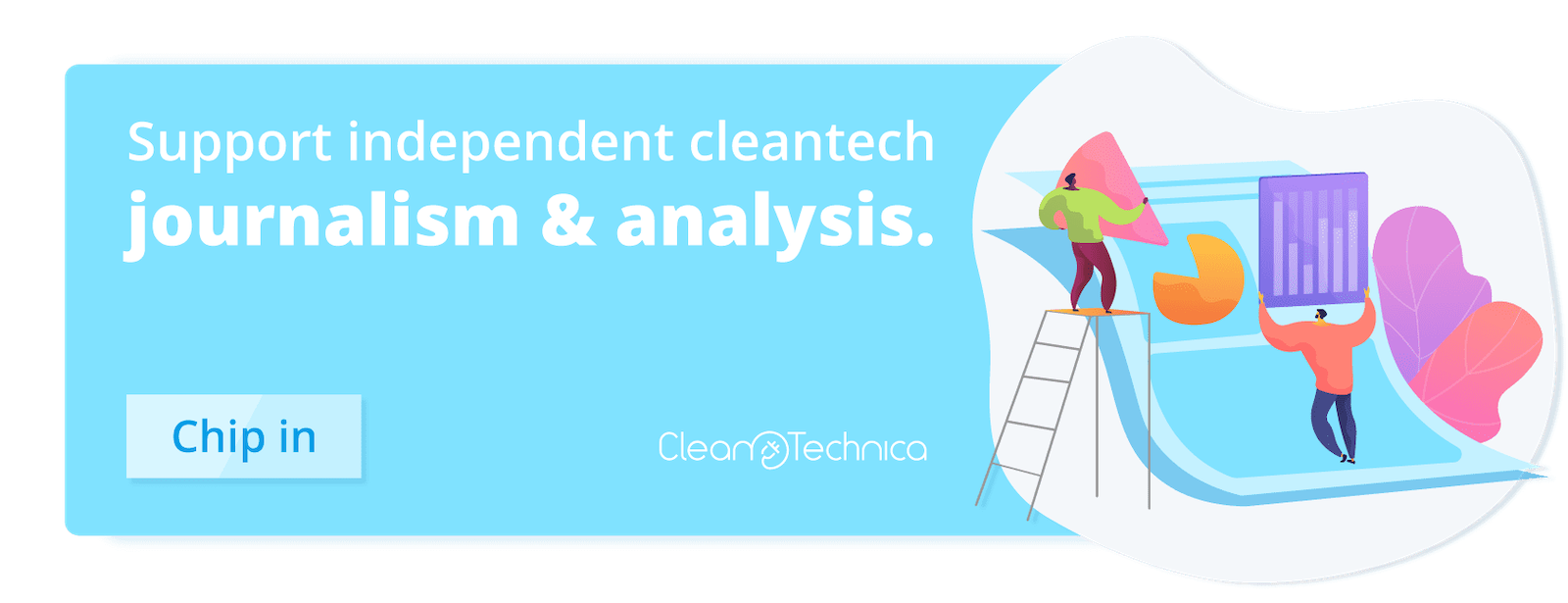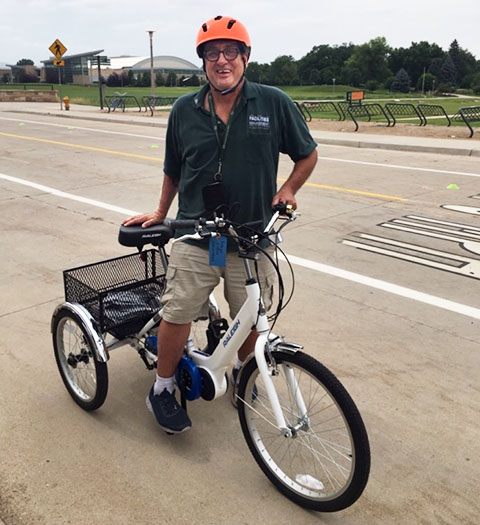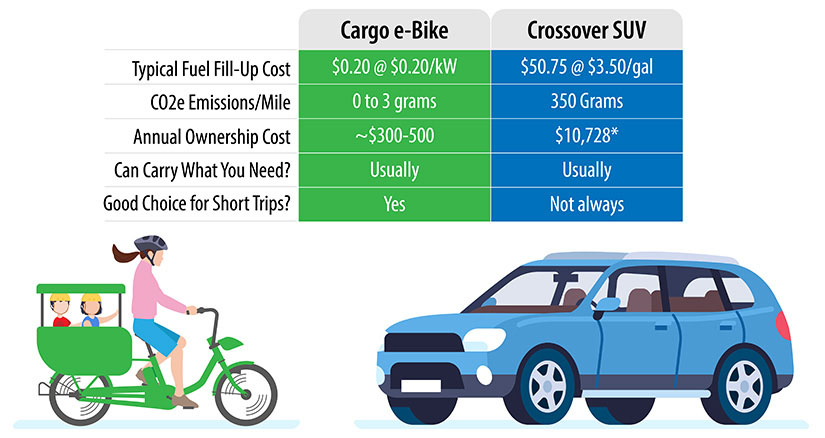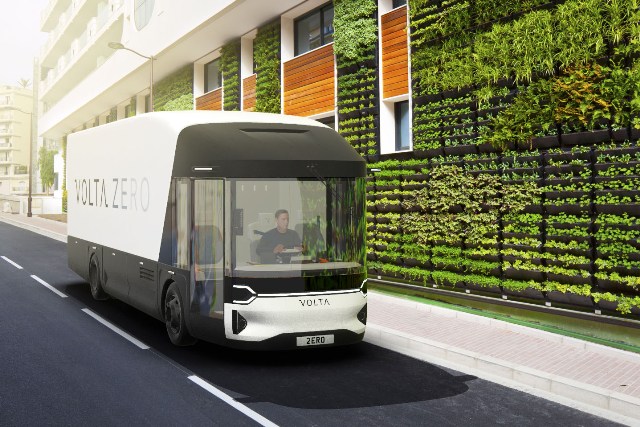
Power-assisted bicycles have existed for more than a century. While gasoline-powered bicycles are no longer mainstream, today, battery-powered electric bicycles (e-bikes) are more popular than ever. Sales figures for e-bikes are significantly outpacing all other electric vehicles.

A participant in the Fort Collins CanBikeColorado Program was thrilled that an adaptive three-wheeler e-bike was an option. Photo from the Colorado Energy Office
“Most people’s first experiences with electric vehicles are with an e-bike, not an electric car,” said Andrew Duvall, transportation behavior analyst at the National Renewable Energy Laboratory (NREL) specializing in micromobility research. “To support the adoption of e-bikes, we need policies to encourage more people to try them out.”
The 2023 Colorado Electric Vehicle Plan released earlier this year includes e-bikes and the development of related policies and incentives as a preeminent focus. As part of its strategy, the Colorado Energy Office (CEO) teamed up with the U.S. Department of Energy’s NREL to understand how to increase the adoption of and access to e-bikes through the Can Do Colorado e-Bike Pilot. The laboratory’s NREL OpenPath tool was critical to informing these insights by collecting holistic travel data. The nearly two-year pilot distributed about 200 e-bikes and 50 e-bike-share memberships to low-income essential workers in diverse locations across Colorado. As the nation’s largest e-bike program, its results are not only informing practices, policies, and additional pilot programs statewide, but outside of Colorado as well.
Results From Colorado Pilot Demonstrate Utility of E-Bikes
The results of the Can Do Colorado e-bike pilot, as outlined in an NREL-authored summary document, show that e-bikes can serve unmet transportation needs while providing a cost-effective and energy-efficient alternative to other modes of transportation. Convenience is among the most notable benefits of e-bikes over other privately owned vehicles. Additionally, charging and repair costs are a fraction of such costs associated with larger vehicles, and riders have the added advantages of parking for free, contributing to reduced traffic congestion, and accessing healthy physical activity.

The results of the Can Do Colorado e-bike pilot, as outlined in an NREL-authored summary document, show that e-bikes can serve unmet transportation needs while providing a cost-effective and energy-efficient alternative to other modes of transportations. Figure by Besiki Kazaishvili, NREL
One of the key insights, NREL researchers found, was that participants generally preferred to walk distances up to one mile and use e-bikes for distances between one and four miles. With a Bureau of Transportation Statistics study reporting that more than half of all daily trips taken in the United States in 2021 were less than three miles, the CEO e-bike pilot findings mean that e-bikes are a viable mode of travel for a majority of daily trips. For distances between four and six miles, the pilot’s participants’ travel choices were split evenly between riding e-bikes, driving alone, and sharing rides.
“It’s all about picking the right tool for the job,” said K. Shankari, an NREL director’s fellow who developed the pilot’s data collection tool. “Choosing between cars and bicycles is a false dichotomy. We should look at ‘yes, and.’ For long trips, yes, people can drive cars and share rides to be more energy efficient. And for shorter trips, riding a bike may be more appropriate some of the time.”
In the pilot, participants chose to use e-bikes for 28% of all trips, many of which were made for access to employment. The energy savings achieved by using e-bikes instead of single-occupancy vehicles were close to 40 megawatt-hours across the program. The program-wide energy savings is nearly equivalent to the energy use of 1,000 average-sized (2,000 square foot) homes for an entire day.
NREL Tool Informs Development of E-Bike Incentives and Infrastructure
Collecting e-bike data was accomplished by NREL’s Open Platform for Agile Trip Heuristics (NREL OpenPATH)—a modular, open-source platform that enables people to automatically track their travel modes and measure their associated energy use via a smartphone app. It provides a comprehensive view of travel behavior by comparing individual e-bike use to other travel modes and calculating the corresponding carbon footprint from all travel modes.
“While shared e-bike systems automatically collect data, they aren’t tied to individuals,” Duvall said. “NREL OpenPATH follows individuals, tracking itineraries—real use cases and travel behavior—which are critical to informing how e-bike infrastructure and transportation projects should be designed and prioritized for funding.”
A publicly available version of the CanBikeCO app based on NREL OpenPATH is available from the Google Play and Apple app stores to participate in ongoing programs. Meanwhile, an “open-access” version is available for individuals who are not part of a study but are interested in tracking their travel emissions. NREL OpenPATH is also being implemented for e-bike programs and investments in California, Massachusetts, and other locations around the nation.
E-Bike Interest and Programs Growing Across the Nation
The growth of e-bike programs and policies around the United States demonstrates increased national interest in sustainable transportation and micromobility. Taken together with reports in recent years of a burgeoning demographic that is shifting away from car ownership as a primary means of transportation, e-bikes may not replace all car trips, but their market share continues to expand.
“Getting people to think about different modes of transportation and different fuel sources is a challenge,” said Paul Wessel, Greater New Haven Clean Cities Coalition director and a member of Connecticut’s e-bike subsidy program board. “Subsidy programs help people look at other options. What’s especially exciting about e-bikes is that, as a means of transportation, they’re alternative fuel vehicles that are financially accessible to people across the economic spectrum and are great for achieving the vision of the White House’s Justice40 initiative.”
Coalitions with the U.S. Department of Energy’s Clean Cities Coalition Network around the United States specialize in promoting the use of alternative fuels and advanced vehicle technologies in transportation, and the Greater New Haven branch helped inform the Connecticut Hydrogen and Electric Automobile Purchase Rebate (CHEAPR) that offers various e-bike incentives.
In Colorado, e-bike programs and incentives continue to grow. Participants include urban and rural communities and applications are open to tribal governments and other community-based organizations. For remote and underrepresented settings where vehicle access and mode options may be limited, e-bikes are especially promising mobility solutions. Various e-bike models are designed to fit the needs of differently abled people, haul cargo, and even handle riding through fields, unpaved paths, and steep inclines. E-bikes additionally do not require as much parking space as a passenger car.
Partnering With NREL for Data Collection
A journal article that includes in-depth analysis is slated to be released later in 2023. The Colorado e-bike pilot data will also be publicly available in NREL’s Transportation Secure Data Center later in 2023 to augment future transportation research and analysis.
“The Colorado e-bike pilot showed that people could make the shift to e-bikes for errands and other activities—the data we collected demonstrates that,” said Sarah Thorne, CEO’s senior program manager of transportation fuels and technology. “We just happened to be the first in the country to implement a program like this, collect data at the same time, and inform other programs launching nationwide. With the explosion in e-bike programs in the last two years, our data does show that we’re at the forefront of that, and that’s pretty exciting. NREL helped us make that happen.”
Learn more about NREL’s transportation and mobility research, including the laboratory’s mobility behavioral science capabilities and opportunities to implement NREL OpenPATH. And sign up for NREL’s quarterly transportation and mobility research newsletter, Sustainable Mobility Matters, to stay current on the latest news.
Article from NREL.
I don’t like paywalls. You don’t like paywalls. Who likes paywalls? Here at CleanTechnica, we implemented a limited paywall for a while, but it always felt wrong — and it was always tough to decide what we should put behind there. In theory, your most exclusive and best content goes behind a paywall. But then fewer people read it! We just don’t like paywalls, and so we’ve decided to ditch ours. Unfortunately, the media business is still a tough, cut-throat business with tiny margins. It’s a never-ending Olympic challenge to stay above water or even perhaps — gasp — grow. So …




